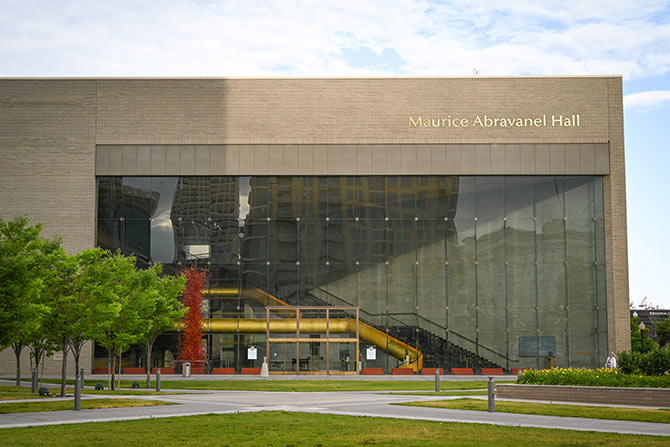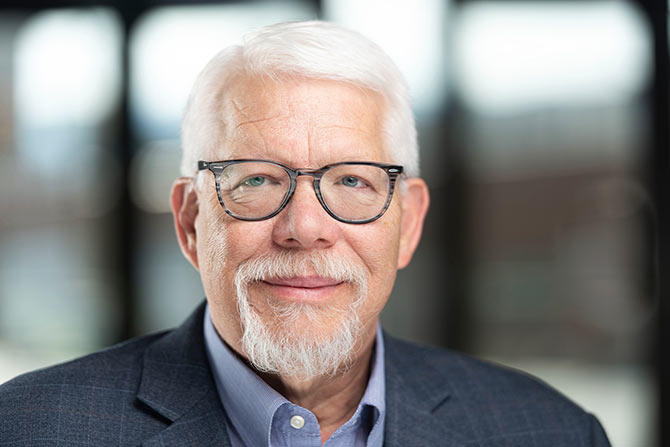Fowler Ferguson Kingston Ruben (FFKR) was founded in 1976. This is how Frank Ferguson remembers it: “I was friends with Bob Fowler. We were both competing for Symphony Hall and Bob got it. We were friends, so I wrote a letter to Bob and said, ‘I really feel crummy. I really wanted to have that job, but, if I can’t have it, I want you to have it.’ A couple weeks later, Bob asked me to come over and said, ‘I want you to be my design consultant,’ … because it had to be done in a short period of time. Bob believed in me like I believed in him. We worked side by side. He was the architect; I was his design consultant.”
“There was enormous pressure, but sometimes pressure helps you with the decision-making process and your brain works better because you can’t sit around and dream about things. You have got to get things done. Without Bob, it would never have happened. It wouldn’t have been the same without me, but I had no political weight. Bob had plenty of political weight (to sell the design). All this time we were just having a great time, it was wonderful.”
So, Enteleki (Ferguson’s firm that also included Ray Kingston) and Robert Fowler Architects merged; FFKR’s first project was Abravanel Hall, for Salt Lake County. In those days, FFKR was a studio — built on the talents and charisma of the principals. Ferguson: “When a new project would come in the office, we would assign it to one of us, and we just worked together and had very good people. We were careful that we worked hard every day, and efficiently, and we were able to make our payroll. You couldn’t draw a corporate structure of either Enteleki or FFKR. It was a very artistic environment.”
FFKR is now edging up on 50 years old. It is still known as a capital “D” Design firm. It is also very successful, and with 158 employees and offices in Utah and Arizona, it is decidedly more of a design business than a studio. I spoke with Mike Leishman, the firm’s president, about FFKR’s evolution, growth and the keys to its current success.
Leishman: “We have been very fortunate and blessed. We started out well, with Symphony Hall. Then, through the tenacity of the founders, and their carefully chosen successors, we have had a lot of great projects: the Jerusalem Center for Near Eastern Studies, Salt Lake Tabernacle, Hillcrest High School, Talking Stick Resort, Neilsen Rehabilitation Hospital, Delta Center. 85% of our work is for return clients. But ultimately, our legacy is built on our people. We have people who care at all levels.”
Leishman says that when FFKR first started, the founders were more in control of what went out the door. As the firm evolved, however, they have learned how to create opportunities for people on project teams to participate at all levels. “We don’t have a design committee, and we provide a wide range of design solutions. We are open with our design.”
Keeping the Quality High
So, how does FFKR ensure the quality of their product, despite the growth of the firm and empowerment of more employees at all levels?
Leishman answers, “It starts with the buy-in of the project team understanding that we have been contracted to do the work from start to finish. We keep staffing the project until it is done right. Yes, we want our projects to be profitable, but we all win when projects are good. The recipe for success is high quality, and no matter what the financial condition is internally, we do the project and we do it right. Some years have been painful. We try to learn from those experiences, from our mistakes.”
And how do they leverage quality and a healthy bottom line?
Leishman: “One of the things we aim to do is to have design be finished by the end of design development; all the primary design decisions should be made. If those design decisions go into Contract Documents, that is when things go bad; you have to know when to stop designing. The second piece of the equation is applying the ‘Fatal Flaw Test.’ If you are in CDs or construction, will the design change impact the long-time viability of the project, or is it just a preference?”
Retention and Succession
FFKR has a very high personnel retention rate and a very low turnover rate. Their people often stay with them for decades and settle into the most appropriate career positions as they mature. Frequently, this has meant customizing jobs around both individual skill sets and availability. “Over the years, we have done a really good job creating really flexible work schedules that accommodate the changes in people’s lives. 25% of our workforce is part-time. There are people at points in their life when they just can’t work full-time. We try to accommodate their personal needs.”
They also don’t try to peg people into permanent positions or studios until they are ready to be there. Initially, when they hire young professionals, they hop around a bit between studios, to determine what they do best, what they enjoy most and which people they can work with. This serves both the career advancement of the employee and the efficiency of the firm by ensuring the likelihood of a comfortable fit. By the time an employee becomes a candidate for principal, they already have clientele and relationships. They have teams.
Additionally, Leishman says, “We have created a successful succession plan. We are now in our fourth generation and working toward a fifth generation.” When the third generation of principals brought on a fourth generation which included him, he believes, “We were not particularly charismatic. What we were was good project managers.” As there wasn’t one individual in the group that stood out as the designer, “the soul of the company,” they created a very socialistic group environment, and very collaborative environment. As a result, the firm became more corporate — which is not necessarily a bad thing for a large design firm, as it encouraged very sound business practices.
There was also a long crossover between generations. “I really liked the way Roger Jackson and Jeff Fisher coached me for five or six years — mimicking their positions,” he says. “It was a great way to learn the job, watching what they were doing. In the long run, it pays off. It is not as abrupt of a change.”
And, of course, it is an investment.
FFKR Goals
What’s next?
Leishman: “Our goal is to expand. At the heart of that is the principal’s ability to collaborate with other principals, making it easy to win.” Practically, what that means, is that partner(s) might have multiple other partners working with them, building an operational platform that isn’t based on a single person, or that could fall apart if they were to leave. The primary reason they want continued growth is that it is the vehicle that provides expanded leadership opportunities. As many people want to be partners, there has to be a bigger pie to slice.
Leishman sees expanding geographically being a likely development. “COVID taught us how to collaborate remotely. As we had work, we were able to use short‑term contracts with people from other firms that were temporarily short of work.” When they opened their office in Arizona, they recruited a core group of people, and the overhead was fairly small. Fortunately, they also had some larger projects that they could use to keep the remote location busy while they were building their Tempe practice. Now they are seeing Arizona clients flowing into that office. Leishman believes the Arizona office has huge potential.
Other FFKR studios are looking outside the Salt Lake Valley and outside Utah for work. The firm is looking at a couple of locations for new offices. He says, “It is about the personality of the principal group. Some people are more willing and able to make those trips and can take the three to five years to invest to build a practice.”
Growth also happens with bigger, better projects. Currently they have four really big projects, with five or six in the wings, so they are in a better position to collaborate with the Big “A” firms on some very large, exciting, complex projects.
“This really allows us a lot of ability to support all of our projects and all of our staff. Even when there is less work in one studio, we have four studios knocking it out of the park; four studios that are generating significant fees. It is beautiful to see.”
“We are always hiring. We have a lot of opportunities for customizable job descriptions even at the principal level. People don’t have a job in the box. We can create positions and slot people where they are strongest. We don’t have a one-size-fits-all; it has allowed us to keep good talent.”
FFKR’s extensive portfolio of past and current work is enviable. Their client list is long and loyal. And, from the ground, it appears that their goals are reachable: steady growth, reasonable profits and stable employee retention. Their brand is solid.
I am also happy to report that they celebrate National Hot Dog Day. Even for one of Salt Lake’s respected design firms, not everything can be about architecture.











